With the challenges facing the world today surrounding how we might protect our environment; the recycling of waste products has been pushed to the forefront of Australians’ minds.
The Holmesglen Institute in Moorabbin is a state government funded Technical and Further Education (TAFE) institution that provides Bachelor of Nursing and Diploma of Nursing courses; a component of all nursing courses is the undertaking of hands-on skill-based education in the laboratory using actual nursing and medical equipment to simulate the various practical procedures and elements of nursing care.1
In a conscious attempt to manage the ever-growing waste problem, Holmesglen, led by the Laboratory Manager, have developed and implemented a recycling programme that incorporates all elements of its practical education. The aim is to prevent nursing supplies adding to landfill.2
The nursing lecturers and nursing students alike, work as a team to separate, recycle, reuse and repurpose nursing supplies whilst simultaneously providing and receiving a well-rounded nursing education (Figure 1).

Figure 1
In managing the risk of infection and the reduction in antimicrobial use, the prevalence of disposable products was developed and monopolised practice.3 Single use packaging is incorporated into daily routines and has created an unsustainable problem.4

From plastic packaging to single use dressing packs, the aim of this program is to reduce landfill waste and greenhouse admissions.5 To its great credit, for many years the health care industry practiced recycling before it became fashionable. The use of sterilisation ‘bombing’ of equipment – bedpans, urinals, carbonisation of beds and reusable metal instruments rather than plastic single use instruments were the norm.6
There are many barriers to recycling in health care. The main arguments for the absence of active recycling programs in the healthcare industry are a lack of governance, appropriate education of staff, commitment to the process and execution stratagems with supportive policies and procedures.7,8
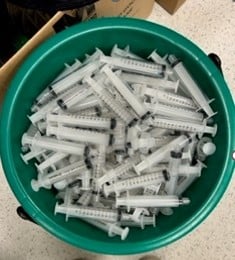
At Holmesglen, we have recognised that there are many opportunities to reduce our landfill and carbon footprint by reusing many single use items such as intravenous lines, syringes and dressing packs.9 We are able to reuse medical equipment as students learn and practice their skills on mannequins so therefore the items are not required to be sterile. Instead for teaching and fidelity purposes, they need to appear to be sterile.
The Recycle, Reuse, and Repurpose Programme
Nursing students are introduced to the recycling program when they commence their education at Holmesglen. Signage has been developed and is displayed in all Nursing Laboratories and in public areas indicating many of the items to be recycled. Special tubs are placed in Labs in all classes and items to be recycled are placed in these. These are then separated, sorted, washed and dried as necessary, repackaged and then placed back into circulation (Table 1). Syringes, intravenous lines, intravenous bags, dressing packs, some dressings, foley catheters, and nasogastric tubes are an example of the items we recycle. Items can be reused many times.
Medication preparation and administration is a key role of the nurse. The teaching of this complex aspect of care is included in the recycling process. We have
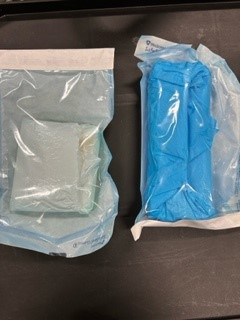
a stock of vials initially purchased from a family run company and once used, they are de-capped, washed, dried and refilled with either water or sodium bicarbonate to imitate medication and then recapped. The aluminium from the de-capping is recycled and the plastic flip tops from the new caps are sent to ANMF ( VIC Branch) for craft purposes.
The rubber stoppers are reused multiple times. Screw top vials are also purchased, and the vials filled with “medication” (baking soda) or water.
Specific labels are printed and applied to the vials as per the laboratory / simulation / Objective Structured Clinical Examination (OSCE) scenario.
All items are repacked in autoclave bags of different sizes. The repackaging creates the impression that the item is sterile and so enables the nursing students to experience and practice the opening of ‘sterile equipment’ during lab sessions. The packaging itself is then recycled as the paper backing is separated from the plastic window and placed in the Institutes cardboard and paper recycling program. It is important to note that no sharps are recycled with all sharps going into appropriate sharps containers.
Our recycling programme also extends from the classroom to the staffroom with staff encouraged to dispose of used pens/markers/highlighters/blister packs and batteries into the appropriately labelled boxes placed in the staffroom. These are then taken to collection points. Cardboard and paper are recycled through the Institutes recycling programme.
The team are proactively searching for new innovations. In 2022, glove recycling was introduced. This project was adopted following a suggestion of a Holmesglen nursing student. All types of gloves – latex, vinyl and nitrile gloves are suitable. The zero-waste initiative enables all staff and students to place their used gloves in purpose provided cardboard boxes which are sent to TerraCycle to be molten and then repurposed into another product.10 This does come at a cost as the boxes need to be purchased and posted. This cost is willingly covered by Holmesglen management.
Table 1

Ongoing Education Key Stakeholders
Both permanent and casual staff together with the students are introduced to the recycling programme at the time of orientation and transition sessions. The primary barrier to purposeful recycling in the healthcare industry is the lack of knowledge regarding recyclable and non-recyclable products before disposal and inadequate control measures.11
Staff are provided with an informative session outlining the aims of the initiative together with actual day to day activities that support the process. The students are provided with regular ‘reminder talks’ during their degree and diploma course.
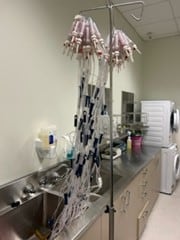
The introduction four years ago of this initiative was initially met with some resistance from both staff and students. The problems were around segregation of recyclable products and risk of sharps injuries regarding IV lines in particular. There are risks associated with recycling of health care equipment and that precautions need to be taken to prevent cross infection and injury.12 The team were forced to problem solve to provide safe and informed alternatives to ensure participation. The purchasing of recycling buckets that had a wide mouth and shallow base were obtained. These are placed on the side of the equipment trolley that contains the equipment for the Laboratory session. This has reduced the risk of sharps injuries to both the teaching staff and the lab staff alike.
These recycling, reuse, repurposing practices do take time and organisation. An awareness of the upcoming Labs is needed to ensure the required items are repackaged and available in the quantities required. At present Holmesglen has a Laboratory assistant for 10 hours per week to assist with these tasks and the Lab Manager integrates the recycling processes into her daily routine. By developing processes and procedures and tackling tasks in a routine and organised way, the recycling process can be streamlined and effective. The Nursing Department considers that the time commitment required is far outweighed by the environmental benefits. Support from staff and students is integral to the program and the feedback we have received from students has been positive.
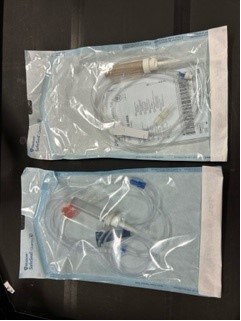
The principal goal of this practice has always been for a greener environment and reducing the carbon footprint of nursing education. If only to make a small contribution in combatting the environmental challenges our world is confronting today. This is an aim for all healthcare workers. However, there are also significant financial benefits to the organisation with an estimated saving of $150,000.00 for the nursing budget annually. The costs of medical equipment are high and are rising. For example, one OSCE for 240 students focussing on intravenous priming of lines, administration of antibiotics and connection of IV to the “patient” saved $8000.
An added benefit has also been to raise an awareness in Nursing students of the amount of landfill that healthcare creates and that it is possible to mitigate this in some circumstances while maintaining the integrity of equipment. These students are the healthcare workers of the future and if they can integrate sustainability into their future practice, society as a whole will benefit.
Nursing education is a fundamental service to the community, which benefits us all and which we all require. It must be provided through both theory and practical means. The overall message here is that nursing education can be undertaken in an environmentally conscious and eco-friendly manner. With simple, yet careful and intricate, practices, this education can be delivered in a brave, ecologically-sound, and fiscally responsible way.

References
-
Australian Nursing and Midwifery Accreditation Council, 2023 https://www.anmac.org.au/
-
United Nations Sustainable Development Goals of number 12, Responsible Consumption and Production, 3, Good health and Well-Being.
-
Campion N, Thiel CL, DeBlois J, Woods NC, Landis AE, Bilec MM. Life cycle assessment perspectives on delivering an infant in the US. Science of The Total Environment. 2012 May;425:191–8.
-
Campion N, Thiel CL, DeBlois J, Woods NC, Landis AE, Bilec MM. Life cycle assessment perspectives on delivering an infant in the US. Science of The Total Environment. 2012 May;425:191–8.
-
https://www.vic.gov.au/about-recycling-victoria.
-
Rasheed FN, Baddley J, Prabhakaran P, De Barros EF, Reddy KS, Vianna NA, et al. Decarbonising healthcare in low and middle income countries: potential pathways to net zero emissions. BMJ. 2021 Nov 9;n1284
-
Azouz S, Boyll P, Swanson M, Castel N, Maffi T, Rebecca AM. Managing barriers to recycling in the operating room. The American Journal of Surgery [Internet]. 2019 Apr 1 [cited 2020 Nov 16];217(4):634–8.
-
Mishra AR, Rani P, Mardani A, Pardasani KR, Govindan K, Alrasheedi M. Healthcare evaluation in hazardous waste recycling using novel interval-valued intuitionistic fuzzy information based on complex proportional assessment method. Computers & Industrial Engineering. 2020 Jan;139:106140.
-
https://cicm.org.au/getattachment/Fellows/Special-Interest-Groups/Environmental-Sustainability/Resources/A-beginners-guide-to-Sustainability-in-the-ICU.pdf.aspx
-
https://zerowasteboxes.terracycle.com.au/products/disposable-gloves-zero-waste-box
-
Azouz S, Boyll P, Swanson M, Castel N, Maffi T, Rebecca AM. Managing barriers to recycling in the operating room. The American Journal of Surgery [Internet]. 2019 Apr 1 [cited 2020 Nov 16];217(4):634–8.
-
Mishra AR, Rani P, Mardani A, Pardasani KR, Govindan K, Alrasheedi M. Healthcare evaluation in hazardous waste recycling using novel interval-valued intuitionistic fuzzy information based on complex proportional assessment method. Computers & Industrial Engineering. 2020 Jan;139:106140.
Authors:
Janet Conner BN, Diploma of Sustainable Living. Grad Cert Adolescent Health & Welfare is Nursing Laboratory Manager at Holmesglen Institute of TAFE
Michelle McAlister, BN, Grad Cert Diabetes Education, Grad Dip Midwifery – Bachelor of Nursing , Master of Nursing Lecturer at Holmesglen Institute of TAFE



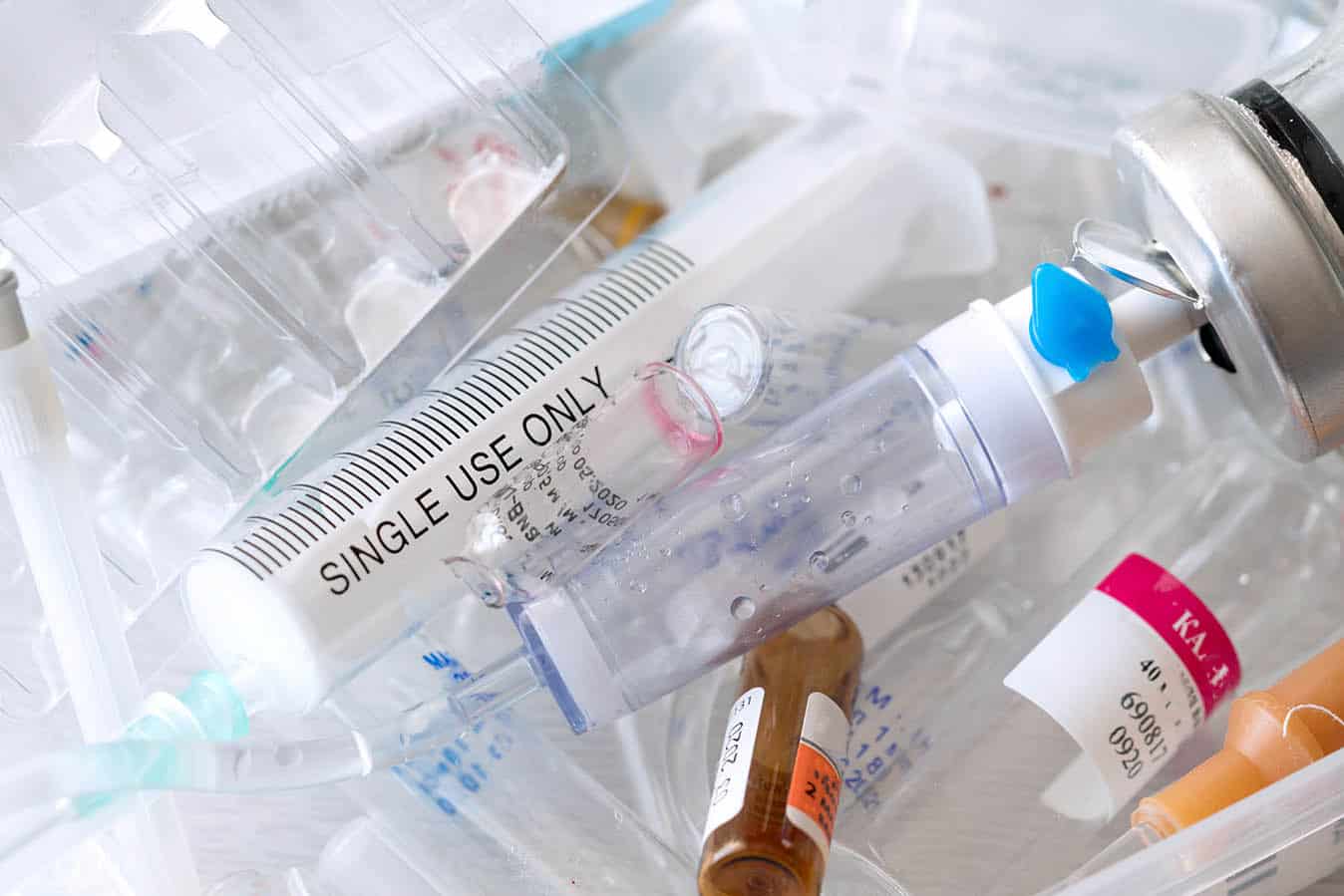


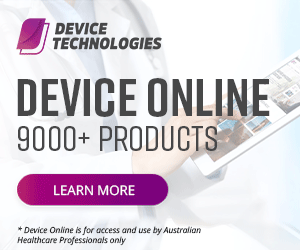

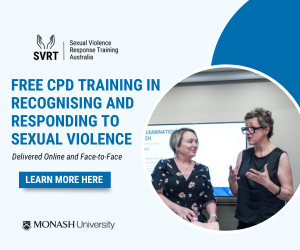

One Response
Excellent read. This article opens your eyes more to the realisation of what is being disposed of every day in the workplace.